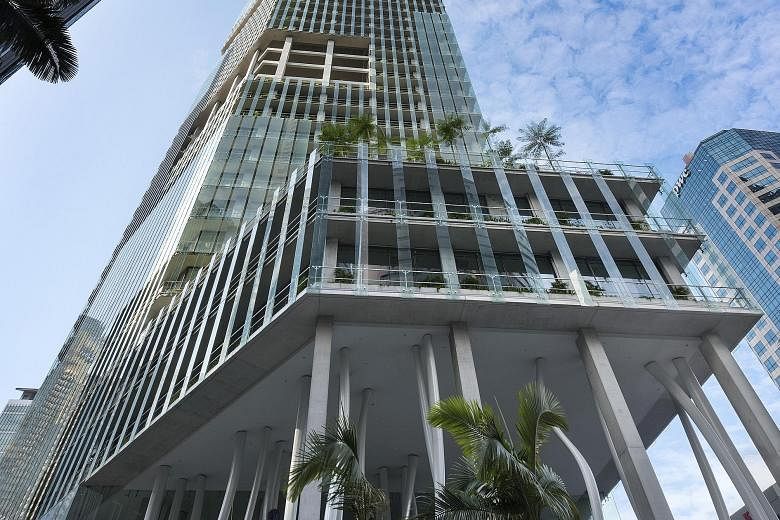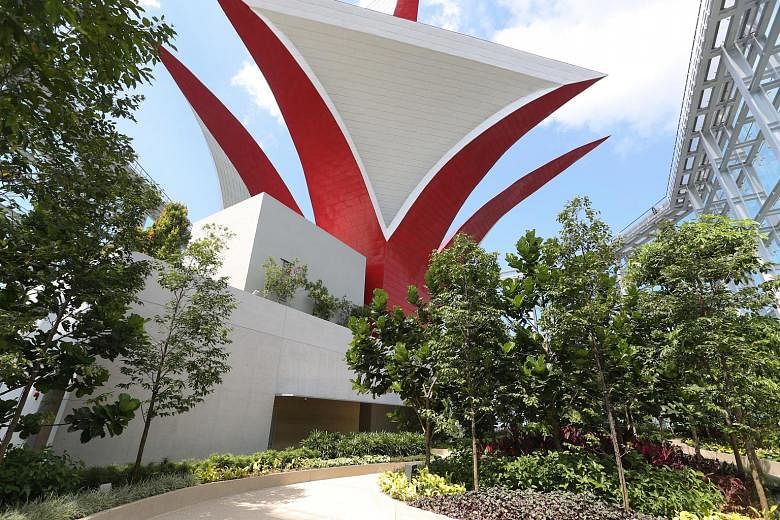Even if he is a Pritzker Prize laureate, Toyo Ito still doubts his own work at times.
On a recent visit to check out CapitaGreen in Market Street, a sleek office tower he designed, the Japanese architect reveals that he had not been sure its plans would get the stamp of approval.
"It would be unlikely that a building like this would be accepted in Tokyo because it would be tough to maintain," says Ito, 74.
"So, when I did my first presentation with developer CapitaLand, I only half-believed that they would accept the plan. But they liked it."
The skyscraper - designed like a plant growing towards the sun - has plants growing such that they will eventually cover more than half the facade.
There is also a sky forest as well as wind funnels on the rooftop that help cool the building.
Occupying the site of the former Market Street Carpark, the tower, which has 703,000 sq ft of lettable area, was completed last year. It is the 11th tallest building in Singapore.
With its numerous green features, the $1.4-billion building is on trend with the sustainable architecture movement.
Ito says he would have designed a green building, even without regulations by Singapore's Building & Construction Authority.
"Singapore used to be covered in forests, but as the city developed, all the greenery had been lost. There must be ways to recover it. With a skyscraper, we can do vertical greenery instead," he says.
The architect tapped on the building's height to help reduce temperature within it.
Standing at 245m, the tower sees faster wind speeds on higher floors, so he designed a flower-like structure that seems to grow out of its top. The flower petals, or "wind scoops", channel cool air into the centre of the building, deliberately left a void; from there, because cool air sinks, it circulates down to the lower levels.
"It's like a big tree in the city that is breathing," he adds, sketching the concept on a piece of paper in seconds, by way of explanation.
CapitaGreen won the 2015 Best Tall Building Award for Asia & Australasia Region at the Council on Tall Buildings and Urban Habitat awards this year. It is also one of the greenest buildings in Singapore's Central Business District.
An art installation, titled Above Below Beneath Above, by Danish- Icelandic artist Olafur Eliasson, 48, continues the plant theme at the building's entrance: a cluster of tall, twisting pillars with shimmery lighted balls at night. The effect is that of a magical mangrove root system.
Works by Taiwanese sculptor Ju Ming and British sculptor Antony Gormley also adorn the public spaces.
The ground-floor lobby is expansive, with a triple-height ceiling, while handcrafted Kakiotoshi walls - it is known as the scratched finish in Japan and made of sand, lime and cement - lend an earthy vibe to the space.
Ito says the time for modernist architecture, popular in the 20th century, is over.
"They tried to control nature and felt the city has no space for nature. But for the 21st-century building, architecture needs to develop an interactive relationship between the inside and the outside," he says.
"It should not have concrete barriers nor should it have an artificial environment inside."
Life for the jetsetting architect has remained roughly the same after he won the prestigious Pritzker Architecture Prize in 2013.
Ito, who is also behind the VivoCity megamall, says that despite garnering much attention after receiving the coveted prize, he runs his 50-strong firm as before.
"I prefer to keep my studio at this size. I remember all my staff's names and I prefer to involve them deeply in every project. So even if there is an opportunity to do a big project, I will say no."
His projects in Singapore, aside from CapitaGreen, include recently completed student dormitories at the Nanyang Technological University; and The Crest Condo, an upcoming 469-unit condominium in Prince Charles Crescent.
Despite a busy schedule, the youthful-looking Ito indulges in his love for golf while looking after his projects around the world.
Smiling, he says: "European architects are still fixed in their design ways. The change to build greener buildings should start from Asia. I don't think they (Westerners) will listen, but we can start."




